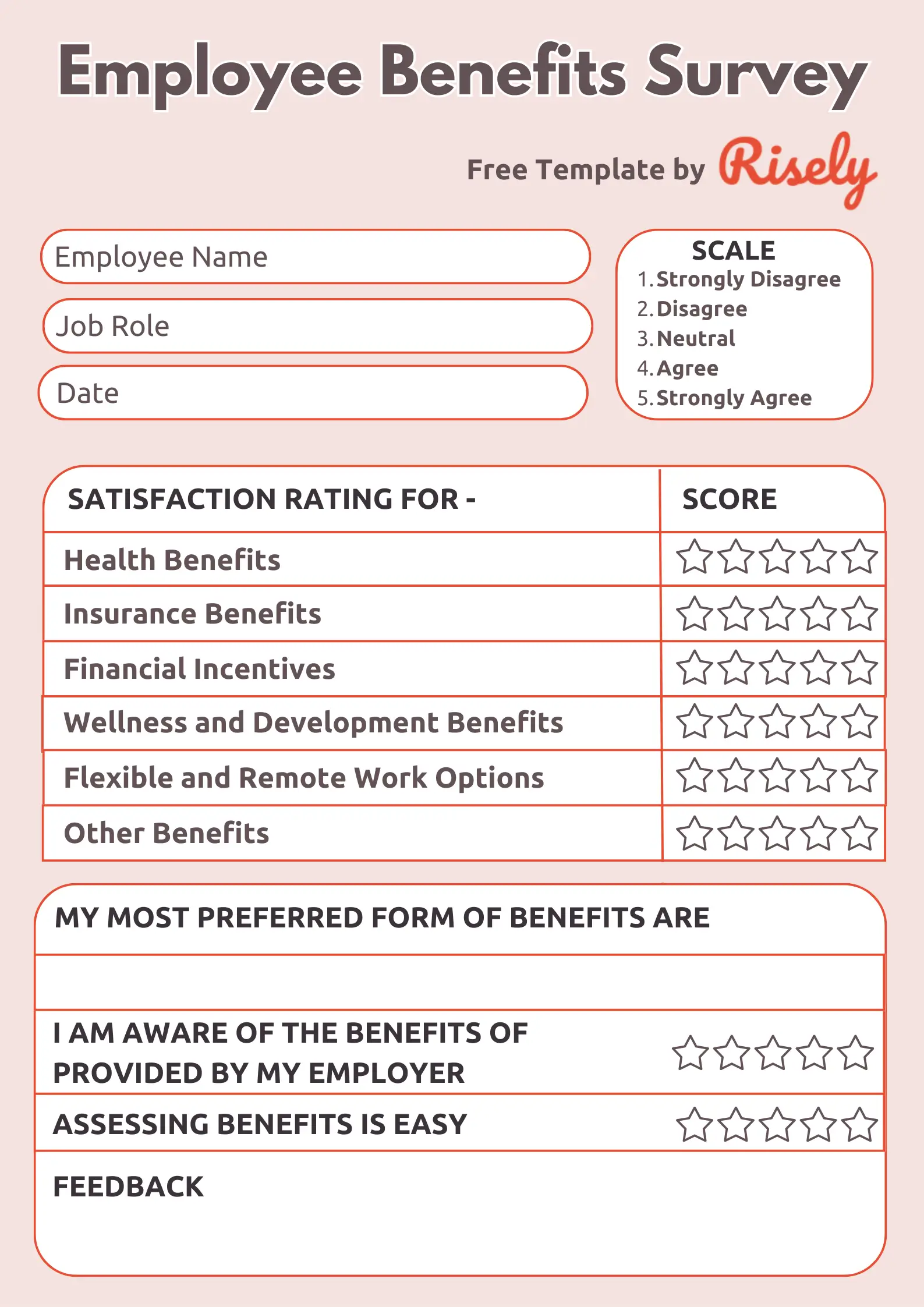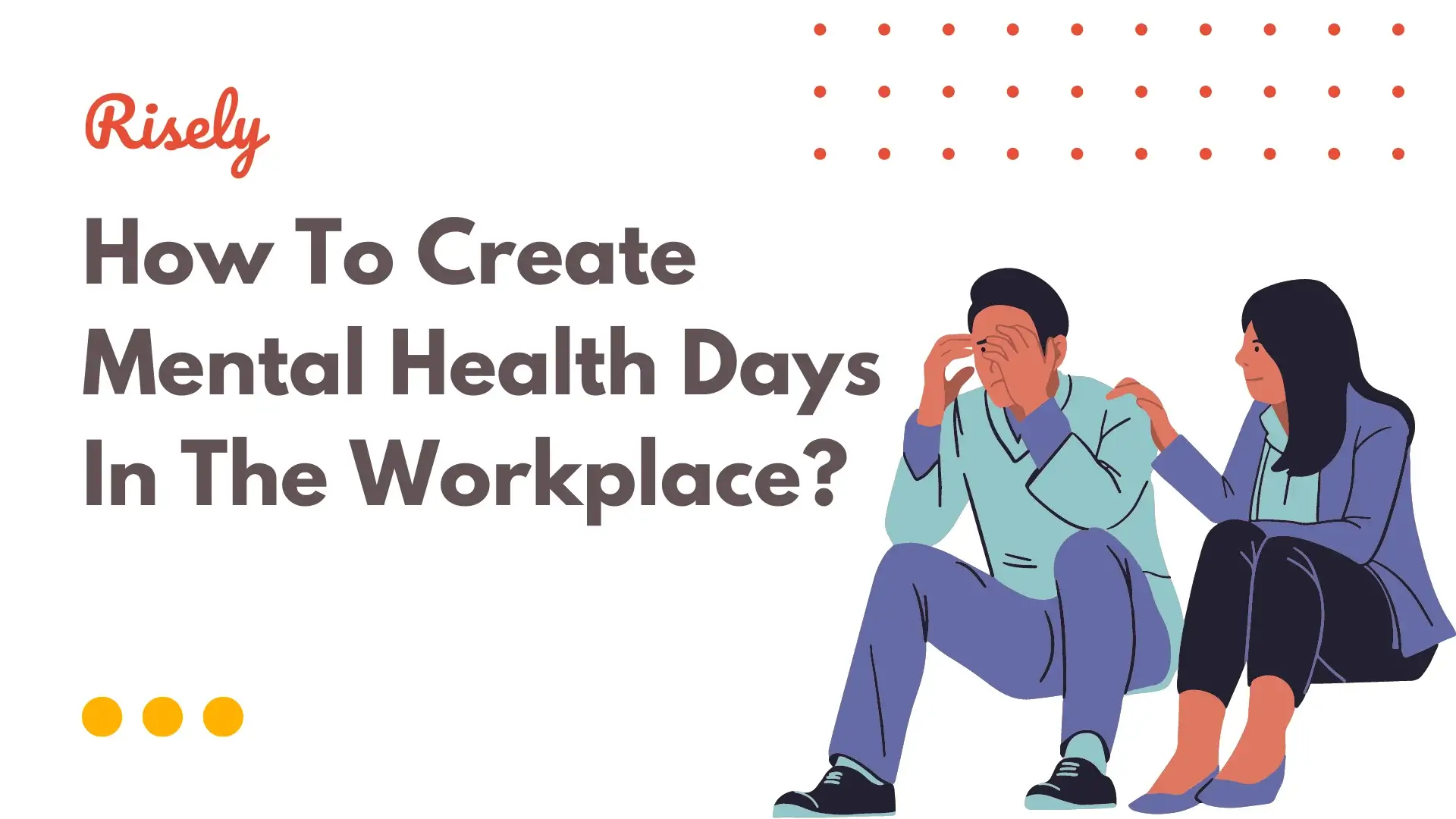Employee Benefits Survey: Complete Guide (17 Top Questions and Free Template)
As an HR professional, understanding what motivates your employees is critical to creating a productive and happy workplace. Employee Benefits Surveys are an effective tool for gauging employee satisfaction with their current benefits package and identifying areas of improvement. This comprehensive guide will cover everything you need to know about conducting an Employee Benefits Survey. From understanding the different types of surveys to crafting the perfect questions, we have got you covered. We will also provide you with a free template to start immediately. By the end of this guide, you will have the knowledge and tools to create a benefits package that your employees love and value.- Employee Benefits Survey: Complete Guide (17 Top Questions and Free Template)
- Understanding Employee Benefits Surveys
- Key Areas to Cover in an Employee Benefits Survey
- How to Conduct an Effective Employee Benefits Survey?
- Crafting the Perfect Employee Benefits Survey Questions
- Employee Benefits Survey Template – Free Resource!
- Maximizing Survey Participation
- Analyzing and Utilizing Survey Results
- Pitfalls to Avoid When Conducting Employee Benefits Surveys
- Conclusion
- Other Related Blogs
Understanding Employee Benefits Surveys
Employee benefits surveys are a tool organizations use to gather feedback and insights from their employees regarding the benefits and perks they receive as part of their employment. These surveys typically include questions about the satisfaction levels, preferences, and perceived value of various employee benefits, such as health insurance, retirement plans, paid time off, flexible work arrangements, wellness programs, and more. These surveys aim to assess the effectiveness and relevance of current benefit offerings, identify areas for improvement or adjustment, and ensure that the benefits provided align with employee needs and expectations. Read more: The Many Faces of Employee Benefits: A Complete GuideWhy do Employee Benefits Surveys Matter?
Understanding employees’ needs and preferences is crucial in creating a positive work environment and increasing employee satisfaction. Employee benefits surveys play an essential role in achieving this. Employees who clearly understand what’s covered in their benefits package are 101% more likely to trust company leadership according to Metlife. These surveys provide organizations with insights to attract and retain top talent by offering competitive work benefits such as healthcare benefits, retirement plans, and life insurance. By conducting regular surveys, employers demonstrate their commitment to employee feedback and improve the employee benefits plan. By collecting input through these surveys, employers can make informed decisions about their benefit packages and enhance employee satisfaction and engagement. In the ever-changing world of work, employee benefits surveys are vital to stay updated on the evolving needs of employees.Types of Employee Benefits Surveys
Employee benefits surveys serve different purposes and provide valuable insights into various aspects of employee benefits.- Satisfaction surveys measure employees’ overall satisfaction with their benefits, while engagement surveys assess their level of engagement with the benefits offered.
- Needs surveys gather information on specific benefit needs, and benchmarking surveys compare an organization’s benefits with industry standards.
- Perception surveys gauge employees’ perception of the value of their benefits.
Key Areas to Cover in an Employee Benefits Survey
Managers should ensure that the following areas are covered:- Assess employee engagement with current benefits to gauge their level of satisfaction and involvement.
- Find out which benefits your employees love the most to prioritize and focus on those areas.
- Asking questions for competitive comparison helps you understand how your benefits stack up against other companies.
- Identifying employee satisfaction with benefits provides insights into areas for improvement.
- Setting goals for the survey ensures clear objectives and outcomes.
Assessing Employee Engagement with Current Benefits
Assessing employee engagement with current benefits is crucial for organizations to identify areas where employees actively utilize them. This understanding helps improve overall benefits utilization and tailor benefits offerings to meet employee needs. Employee engagement with current benefits is a strong indicator of the effectiveness of the benefits program, playing an essential role in driving employee satisfaction and retention. Companies can implement best practices by assessing employee engagement, such as offering healthcare benefits, retirement plans, and life insurance, to create a compelling employee benefits plan.Finding the Benefits Your Employees Love
Creating a benefits program that meets the needs of your employees is crucial. Finding the benefits that resonate with them can drive higher employee satisfaction and enhance recruitment efforts. Identifying the most popular benefits allows for resource allocation towards high-impact options. This strategic approach to offering work benefits not only informs decisions about benefit offerings but also attracts top talent. Healthcare benefits, retirement plans, and life insurance are some of the essential types of employee benefits that play an important role in the world of work.Competitive Comparison across the industry
Asking questions for competitive comparison is a valuable practice for organizations looking to benchmark their employee benefits against industry standards. By understanding how their benefits stack up against competitors, organizations can attract and retain top talent. Additionally, asking these questions provides insights into emerging benefits trends in the industry. It allows organizations to identify areas for improvement in their own benefits program. Comparing benefits with competitors is an essential strategy for staying competitive in the ever-evolving world of work.Identifying Employee Satisfaction with Benefits
Understanding employee satisfaction with benefits is crucial in helping organizations meet employee needs. By identifying how well the benefits program aligns with employee expectations, organizations can make data-driven decisions for improvement. Employee satisfaction with benefits is a strong indicator of overall engagement and morale within the company. This information allows organizations to address any gaps or areas for improvement in their benefits program. Ultimately, employee satisfaction with benefits is vital in attracting, engaging, and retaining top talent.Other Interesting Reads
How to Conduct an Effective Employee Benefits Survey?
Conducting an effective employee benefits survey requires careful planning and preparation. To ensure valuable insights, it is essential to set clear goals and objectives for the survey. Choosing the right questions and survey format is crucial for accurate data collection and analysis. Communicating the survey purpose and expectations to employees increases survey participation. Additionally, analyzing and acting upon survey results is critical in optimizing the benefits program. By following these best practices, organizations can gather valuable employee feedback and make informed decisions to enhance employee benefits plans.Setting Goals for the Survey
Setting clear goals for the survey is crucial as it helps define the desired outcomes and focus. Organizations can tailor the survey questions and analysis accordingly by having specific goals, ensuring that it provides actionable insights for improving the benefits program. Clear objectives also serve as a benchmark for evaluating the success and effectiveness of the survey. Moreover, setting goals for the survey demonstrates the organization’s commitment to employee engagement and satisfaction. Healthcare, remote work, retirement benefits, and other essential aspects of work benefits can be considered when setting these goals.Timing and Frequency of the Survey
When conducting an employee benefits survey, it is essential to determine the ideal timing and frequency. Conducting the study annually allows for tracking changes and trends over time. It’s crucial to balance working the survey frequently enough to capture relevant information and not overwhelm employees. Additionally, consider any significant changes in the benefits program when deciding on the survey frequency. Aligning the timing of the survey with other essential company events or milestones can also be beneficial.Evaluating Employee Benefits Based on Survey Results
Evaluating employee benefits based on survey results allows organizations to identify strengths and areas for improvement in their benefits program. By analyzing the survey data, companies can gain insights into which benefits are most valued by their employees. Looking for patterns and trends in the survey responses helps make informed decisions about the benefits program. Benchmarking the survey results against industry standards provides a broader perspective. Using the survey results as a guide enables organizations to make data-driven changes to their employee benefits plan.Crafting the Perfect Employee Benefits Survey Questions
Crafting the perfect employee benefits survey questions involves using open-ended and close-ended questions to gather qualitative and quantitative data. To ensure comprehensive coverage, include questions that address various aspects of the benefits program, such as health insurance, retirement savings, and wellness benefits. It is essential to clearly define the objectives of each question to elicit accurate and meaningful responses. Avoid leading or biased questions that may influence the answers, and keep the survey questions concise and easy to understand to encourage higher response rates. Best practices in survey design can help ensure the effectiveness of the employee benefits survey.Questions Focusing on Health and Wellness Benefits
Assessing employee satisfaction with current healthcare coverage is crucial to understanding their needs. Inquiring about the utilization and effectiveness of wellness programs provides insights into their impact on employee well-being. Asking about the availability and accessibility of mental health support shows a commitment to addressing holistic wellness. Gathering feedback on overall satisfaction with wellness benefits helps identify areas for improvement. Lastly, exploring the impact of health coverage on employee well-being and job satisfaction offers valuable insights into the role healthcare benefits play in the world of work.- On a scale of 1 to 5 (1 being very dissatisfied, 5 being very satisfied), how satisfied are you with the health and wellness benefits provided by our organization?
- What specific health and wellness benefits do you find most valuable, and why?
- Are there any health and wellness benefits you feel are lacking or could be improved? Please describe.
- Do you believe our current health and wellness programs effectively promote a healthy work-life balance?
- a. Yes
- b. No
- Are there any suggestions you have for enhancing our health and wellness offerings to better meet your needs and preferences?
- Have you encountered any challenges or barriers when trying to utilize our remote work or flexible scheduling options? If so, please describe.
- Are you aware of the process for accessing and utilizing our health and wellness benefits?
- a. Yes
- b. No
Probing into Learning and Development Benefits
Evaluate employee satisfaction with the current learning and development opportunities, including training and development programs. Determine the perceived value of tuition reimbursement programs and their impact on career growth. Gather feedback on the effectiveness and availability of learning and development benefits. Additionally, inquire about aligning these benefits with employee goals and aspirations. By probing into learning and development benefits, organizations can better understand how to enhance employee satisfaction, foster career growth, and align their offerings with employee needs and aspirations.- How satisfied are you with the learning and development opportunities provided by our organization, on a scale of 1 to 5 (1 being very dissatisfied, 5 being very satisfied)?
- Which specific learning and development benefits have contributed most to your professional growth and job satisfaction?
- Do you believe there are any gaps in our current learning and development programs? If so, please explain.
- Are you aware of all the learning and development resources available to you as an employee?
- a. Yes
- b. No
- What recommendations do you have for improving our learning and development offerings to better support your career growth and skills development?
Questions on Parental and Childcare Benefits
Assessing employee satisfaction with parental leave policies ensures working parents feel supported and valued. Inquiring about the availability and affordability of childcare benefits helps identify potential areas for improvement. Gathering feedback on the flexibility of work arrangements allows companies to create a conducive environment for working parents. Additionally, determining the perceived impact of parental and childcare benefits on work-life balance helps gauge their effectiveness. Finally, exploring the need for additional support and resources for working parents ensures that their needs are met effectively.- How satisfied are you with our parental and childcare benefits, including remote and flexible work options, on a scale of 1 to 5 (1 being very dissatisfied, 5 being very satisfied)?
- Which specific parental and childcare benefits have been most helpful to you, and why?
- Do you believe there are any gaps in our parental and childcare benefits or remote/flexible work policies? Please elaborate.
- Have you utilized remote work or flexible scheduling options to balance work and personal responsibilities?
- a. Yes
- b. No
- How can we better support your needs as a parent or caregiver, or improve our remote and flexible work policies to enhance work-life balance?
Employee Benefits Survey Template – Free Resource!

Maximizing Survey Participation
To maximize survey participation, it is crucial to effectively communicate the purpose and importance of the survey to employees. Ensuring employees that their feedback remains anonymous and confidential can further encourage participation. To promote timely completion of the survey, it is essential to provide a clear timeline. Utilizing multiple communication channels, such as email and in-person meetings, can help reach a wider audience. Additionally, offering incentives like prize drawings or recognition can motivate employees to complete the survey.Best Practices to Boost Response Rates
To boost response rates for your employee benefits survey, it’s essential to implement best practices. One critical approach is keeping the survey short and concise to minimize survey fatigue. An engaging and user-friendly survey platform or tool can entice employees to participate. Sending reminder emails at strategic intervals can also increase response rates. To grab employees’ attention, personalize the survey invitation and reminder emails. Lastly, expressing gratitude for their participation and emphasizing the importance of their feedback can further motivate employees to respond.Analyzing and Utilizing Survey Results
Using data analysis techniques, you can uncover critical findings and trends from the employee benefits survey. Once identified, prioritize areas for improvement based on the organization’s goals. Share the survey results with relevant stakeholders and decision-makers, ensuring transparency and accountability. Develop an action plan that addresses the identified issues and makes necessary changes to the benefits program. Finally, communicate the survey results and the action plan to employees, fostering a culture of trust and engagement. By leveraging survey insights, organizations can drive positive change and create a better workplace.Turning Survey Insights into Action
To effectively turn survey insights into action, it is crucial to establish a cross-functional team responsible for implementing the necessary changes. This team will create a timeline and allocate resources to ensure the smooth implementation of identified improvements. Additionally, seeking employee input and involvement in the decision-making process fosters a sense of ownership and enhances the effectiveness of the changes. Developing communication strategies to keep employees informed about the progress of the changes is also vital. Regular monitoring and evaluation of the impact of these changes on employee satisfaction and engagement helps ensure ongoing improvement.Pitfalls to Avoid When Conducting Employee Benefits Surveys
- Complex or Ambiguous Questions: Avoid using overly complex or ambiguous questions in the survey. Confusing language can lead to misinterpretation and inaccurate responses. Ensure that questions are clear, concise, and easily understood by all employees.
- Overloading with Open-Ended Questions: While open-ended questions can provide valuable insights, overloading the survey with them can be overwhelming for respondents and decrease participation. Strike a balance between multiple-choice and open-ended questions to gather comprehensive feedback without overwhelming employees.
- Lack of Personalization: Failing to personalize the survey can make employees feel like just another number. Address employees by name and tailor questions to their specific benefits experiences whenever possible.
- Limited Distribution Channels: Relying solely on one distribution channel, such as email, may limit the reach of the survey. Utilize multiple communication channels, including email, company intranet, and even physical copies for employees without regular access to digital platforms, to ensure broader participation.
- Neglecting Analysis and Action: Conducting the survey is just the beginning. Neglecting to analyze the results and take action based on the feedback received can be a significant pitfall. Ensure that there is a plan in place to thoroughly analyze the data and use it to identify areas for improvement in the benefits program. Communicate the findings and any resulting changes to employees to demonstrate that their input is valued and acted upon.
Conclusion
Employee benefits surveys play a crucial role in shaping a better workplace. By understanding the needs and preferences of your employees, you can tailor your benefits package to meet their expectations. It not only helps in attracting and retaining top talent but also boosts employee morale and engagement. Employee benefits surveys provide valuable insights into what benefits are most valued by your workforce, allowing you to make informed decisions when designing and offering employee benefits. By listening to your employees’ feedback and taking action based on survey results, you show that you value their opinions and are committed to creating a positive work environment. So, consider the power of employee benefits surveys in shaping a workplace where employees feel supported, valued, and motivated.Sharp communication skills can make your benefits plan effective. Test yours now.
Take the free communication skills assessment for managers today to understand the hurdles that limit your success.
Other Related Blogs
How To Create Mental Health Days In The Workplace
How To Create Mental Health Days In The Workplace? Mental health is certainly among the top topics in conversations in workplaces. Mental health days in workplaces are one such initiative…
How Do Managers Impact Employee Wellness?
How Do Managers Impact Employee Wellness? The well-being of employees not only impacts their personal lives but also their performance and productivity at work. While there are numerous factors that…
Building Inclusive Workplaces: DEI Goals and How to Achieve Them
Building Inclusive Workplaces: DEI Goals and How to Achieve Them According to a LinkedIn study, 76% of job seekers mentioned diversity as a critical factor in evaluating potential workplaces. Yet, we…
How to Handle Defensive Behavior in the Workplace? 7 Tips for Managers
How to Handle Defensive Behavior in the Workplace? 7 Tips for Managers All of us have experienced defensiveness at some point in our lives. Whether we’re feeling overwhelmed or insulted,…


